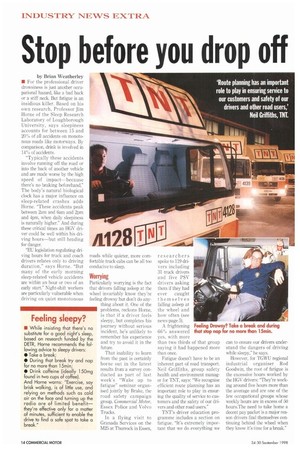Stop before you drop off
Page 16

If you've noticed an error in this article please click here to report it so we can fix it.
by Brian Weatherley • For the professional driver drowsiness is just another occupational hazard, like a bad back or a stiff neck. But fatigue is an insidious killer. Based on his own research, Professor Jim Horne of the Sleep Research Laboratory of Loughborough University, says sleepiness accounts for between 15 and 20% of all accidents on monotonous roads like motorways. By comparison, drink is involved in 14% of accidents.
"Typically these accidents involve running off the road or into the back of another vehicle and are made worse by the high speed of impact—because there's no braking beforehand," The body's natural biological clock has a major influence on sleep-related crashes adds Home. "These accidents peak between 2am and 6am and 2pm and 4pm, when daily sleepiness is naturally higher." And during these critical times an HGV driver could be well within his driving hours—but still heading for danger.
"EU legislation regulating driving hours for truck and coach drivers relates only to driving duration," says Horne. "But many of the early morning sleep-related vehicle accidents are within an hour or two of an early start." Night-shift workers are particularly vulnerable when driving on quiet monotonous roads while quieter, more comfortable truck cabs can be all too conducive to sleep.
Worrying
Particularly worrying is the fact that drivers falling asleep at the wheel invariably know they're feeling drowsy but don't do anything about it. One of the problems, reckons Home, is that if a driver feels sleepy, but completes his journey without serious incident, he's unlikely to remember his experience and try to avoid it in the future.
That inability to learn from the past is certainly borne out in the latest results from a survey conducted as part of last week's "Wake up to fatigue" seminar organised jointly by Brake, the road safety campaign group, Commercial Motor, Essex Police and Volvo Trucks.
In a flying visit to Granada Services on the M25 at Thurrock in Essex, researchers spoke to 119 drivers including 31 truck drivers and five PSV drivers asking them if they had ever caught themselves falling asleep at the wheel and how often (see news page 5).
A frightening 66°0 answered yes, with more than two thirds of that group saying it had happened more than once.
Fatigue doesn't have to be an inherent part of road transport. Neil Griffiths, group safety health and environment manager for TNT, says: "We recognise efficient route planning has an important role to play in ensuring the quality of service to customers and the safety of our drivers and other road users."
TNT's driver education programme includes a section on fatigue. "It's extremely important that we do everything we can to ensure our drivers understand the dangers of driving while sleepy," he says.
However, for Tcwu regional industrial organiser Rod Goodwin, the root of fatigue is the excessive hours worked by the HGV drivers: "They're working around five hours more than the average and are one of the few occupational groups whose weekly hours are in excess of 50 hours.The need to take home a decent pay packet is a major reason drivers find themselves continuing behind the wheel when they know it's time for a break."
Feeling sleepy?
• While insisting that there's no substitute for a good night's sleep, based on research funded by the DETR, Horne recommends the following advice to sleepy drivers: • Take a break;
• During that break try and nap for no more than 15min;
• Drink caffeine (ideally 1 50mg found in two cups of coffee).
And Horne warns: "Exercise, say brisk walking, is of little use, and relying on methods such as cold air on the face and turning up the radio are of limited benefit— they're effective only for a matter of minutes, sufficient to enable the drive to find a safe spot to take a break."




























































































































